Submitted by WA Contents
"Currently available technologies can help to create new energy sources” says Bjarke Ingels
Denmark Architecture News - Jul 04, 2023 - 10:18 3576 views
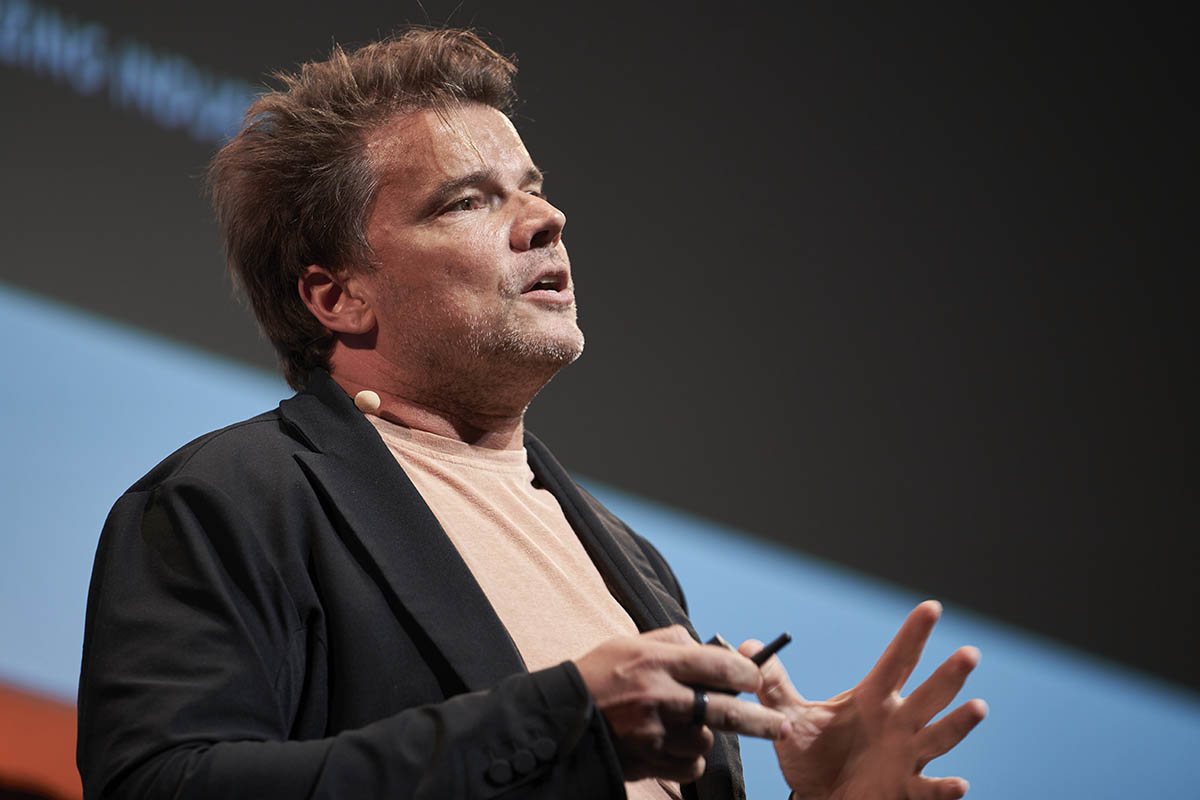
We can create new energy sources with the use of currently available sources and technologies, according to BIG founder Bjarke Ingels in his keynote yesterday at the 28th UIA World Congress of Architects which is taking place from July 2 to 6, 2023 at the Bella Center in Copenhagen, Denmark.
In his keynote, Ingels drew attention to the potential of advanced technologies and renewable sources that could help to transform new energy sources. He particularly emphasized on how these initiatives can also be applied at greater scales.
The 2023 UIA World Congress of Architects started yesterday with a keynote dialogue, titled The EU Goes Green - A New Bauhaus Will Turn Vision Into Reality, presented by Margrethe Vestager - Executive Vice President, A Europe Fit for the Digital Age and Competition, EU Commission and keynote speaker Bjarke Ingels.
The dialogue, inspired by the European Green Deal and the New European Bauhaus, was moderated by Connie Hedegaard.
Ingels also underlined his concept of hedonistic sustainability, claiming that how the two terms of hedonistic and sustainable could become more interesting and open up new possibilities for the future.
"Hedonistic sustainability can also be more enjoyable for the people inhabit buildings"
"We thought maybe this is a general idea, and we called it hedonistic sustainability. The idea that the sustainable city or the sustainable building not only is better for the environment, but it can also be better and more enjoyable for the people inhabit buildings. And it, it is almost like an oxymoron," said Bjarke Ingels, the founder of BIG.
"When you take the two opposite elements that are hard to unite, the social and the liberal, and you combine them, the hedonistic and sustainable that get interesting and new possibilities for the future."
The talks started with the presentation of Margrethe Vestager, Executive Vice President, A Europe Fit for the Digital Age and Competition, EU Commission and she highlighted the role of architects and the challenges that we're faced with.

Margrethe Vestager, Executive Vice President, A Europe Fit for the Digital Age and Competition, EU Commission. Image courtesy of UIA World Congress of Architects 2023
Vestager also emphasized the mission and framework of the European Green Deal and the reasons of why the EU launched the New European Bauhaus.
"Buildings are responsible for 40% of energy consumption in Europe"
"Architecture has been a mirror of how we wanted to live and how we wanted other people to see us, to understand us," said Margrethe Vestager.
"Today we are face with a new challenge; today's challenge is the climate change. And this is indeed a global challenge. Everyone needs to contribute; everyone needs to be part of fighting it."
"We are offering just a European perspective for inspiration as to how we think about it here. And just to frame the challenge in a few European numbers; Europeans, they spent more than 90% of their time in buildings."
"Buildings are responsible for 40% of energy consumption in Europe. Over a third of the greenhouse and gas emissions, they are related to energy, use from constructions," Vestager added.
"The construction sector is responsible for 30% of European waste. So more than ever in history, you, architects are faced with a challenge and with so many, so many competencies converging into architecture, from arts to techniques, from the understanding of people, how they interact, how they want to live."
"As a policy maker, we’re here to help you. You may have heard of the European Green Deal. This is our promise. This is our law by now to cut greenhouse emissions by 55% by 2030, and for Europe to be climate neutral by 2050," she continued.
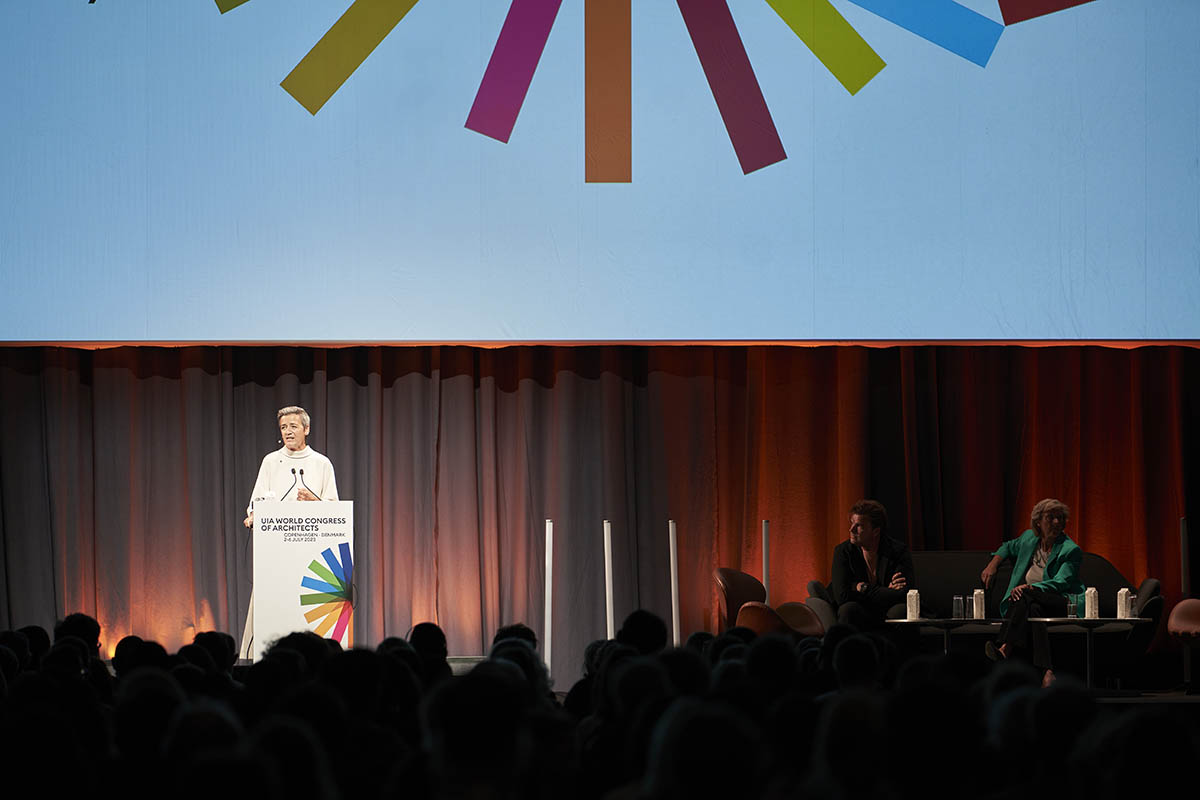
Margrethe Vestager, Executive Vice President, A Europe Fit for the Digital Age and Competition, EU Commission. Image courtesy of UIA World Congress of Architects 2023
"We need to renovate rather than to build from scratch"
Vestager continued that "The EU Green Deal looks at all possible efforts from more recycling to shifting to renewable sources of energy buildings, living spaces, the built environment have a particular importance in this green deal of ours."
"And that is why in 2020, the European Commission launched what we call the new European Bauhaus," she added.
"It takes the inspiration from the design school and we hope to make it at least as influential and incubate it as the school. In short, the aim is to connect the European Green Deal to the daily lives and the living spaces of Europeans."
In her presentation, Vestager drew attention to the three key aspects of The EU's Green Deal.
"We must look at the materials in particular to shift to low carbon or even carbon storing materials"
"There are three things that are important to us: they should be sustainable, and respect our planet," she explained.
"They should be inclusive, make us come together beyond our difference as beliefs or income. And they should be beautiful to give a certain experience of quality and sustainability; we need to reduce the emissions from the sector."
"Starting with the construction sector can be done in many different ways and we need to renovate rather than to build from scratch. We must at least double the rate of renovation and to increase its depth," she added.
"And we also have to apply new green technologies to improve these buildings that we have already built. We must look at the materials we use in particular to shift to low carbon or even carbon storing materials. We are working with every member state of the European Union to boost the production of these advanced materials that we need.”
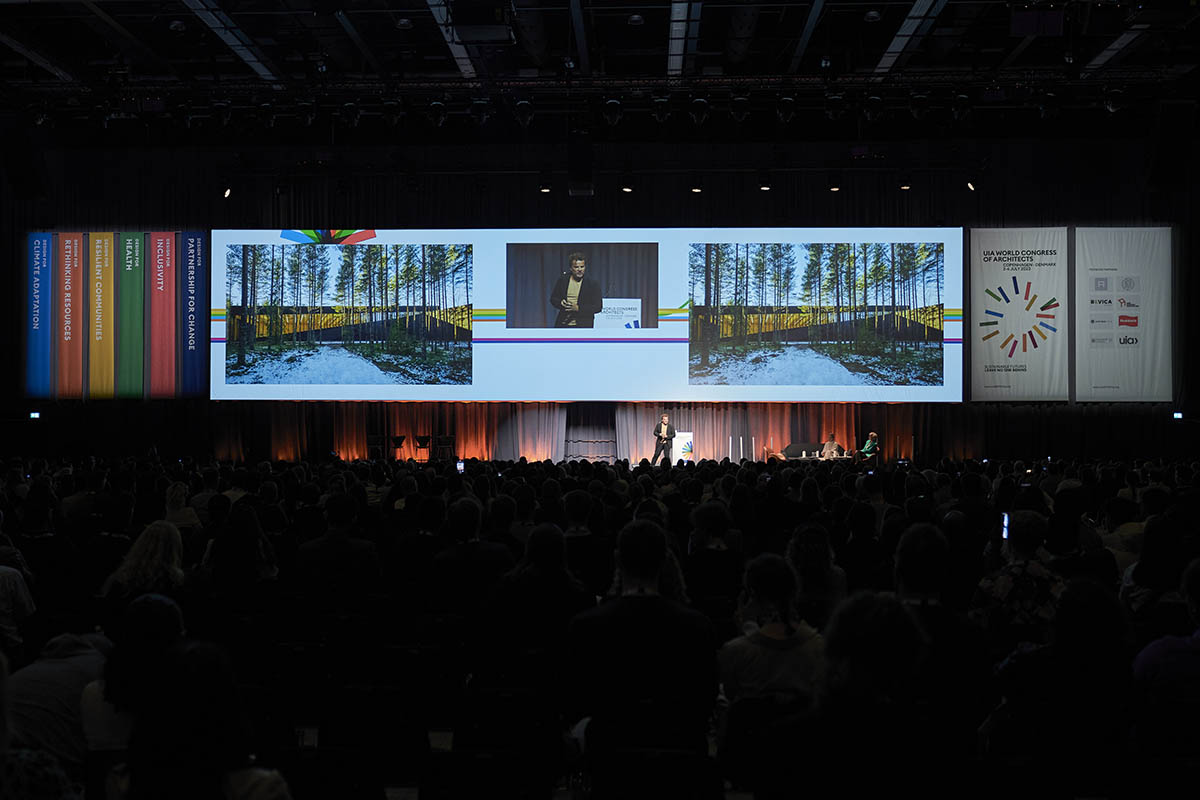
Bjarke Ingels is delivering a presentation on the stage at the Bella Center. Image courtesy of UIA World Congress of Architects 2023
"CopenHill is so clean"
At his keynote, Ingels also highlighted how they built the world's tallest man-made climbing wall at the CopenHill project, which was completed in 2019 in Copenhagen, and how they made the concept of sustainability more enjoyable.
"We've been pursuing this idea of showing how the most sustainable world can also be more enjoyable," Ingels explained.
"For example, CopenHill is so clean, that the steam is coming out of the chimney is actually cleaner than the air of Copenhagen. The project also made us capable of turning its facade into the tallest man-made climbing wall in the world."
"You can also take the elevator and admire all the technology that scrubs the CO2 and filters particles from the air. You find yourself in a manmade mountain meadow, where you can actually ski throughout the year."
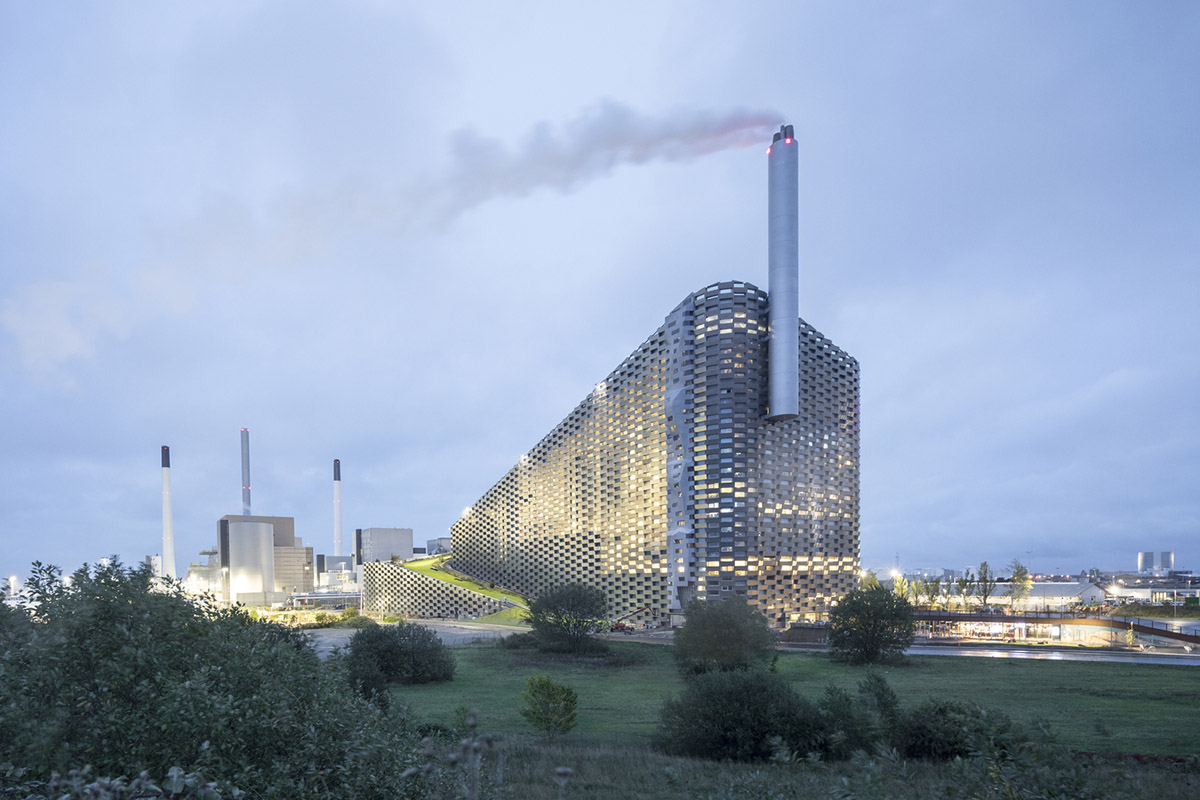
BIG's CopenHill Energy Plant and Urban Recreation Center in Copenhagen was completed in 2019. Image © Laurian Ghinitoiu
"In March 2020, suddenly we had to go entirely remote, like everybody else in the world except our model workshops. We found out that the 3D printers and the plexi sheets we used for our models could be used to making emergency medical equipment like face shields and ventilator tubes," he continued in his presentation.
"So for six weeks, we actually managed to manufacture 20,000 elements and deliver them to the local healthcare providers. We thought that by accident we had learned within our company, in this case, in the model workshop, the tools and the skills to address what was one of the most urgent issues in the world at that time, access to emergency medical equipment."
"And, we asked ourselves: is there anything else we could address like this?," Ingels added.
Bjarke Ingels is delivering a presentation on the stage at the Bella Center. Image © Gul Kozacioglu
New skills and methodology for planners: How to create new energy sources?
Pushing the boundaries of architecture by using advanced technologies and tools, BIG is also known for its investments in high-tech-companies like ICON, an Austin-based company specializing in robotics, software and advanced materials. In 2020, BIG partnered up with ICON as a new investor to expand knowledge and design capabilities for 3D-printed robotic homes in the near future.
Ingels believes that architects can develop their own methodology and use their own skills to make a plan for the future of the planet, by also evaluating renewable sources and the power of technology.
The prolific architect explained this in his talk with numbers: "We thought, what if we actually apply the methodology and the skills of architects and planners to make a plan for the planet?," he said.
"We started looking at numbers, and saw that a total of 173,000 terawatts per year is the total energy consumption all humanity in one year. As you look back 200 years, we were only burning wood, and then we discovered, coal, oil and gas."
"Even today, renewables constitute a small part at the top, but this incredible access to new energy sources. When we look at all the greenhouse gas emissions, mostly you know CO2, you have methane, hydro peroxide and, and air gases as well. And they come from a variety of human activities."
"We had created five verticals; transportation, energy, industry, food and waste that deal with greenhouse gas emissions and climate change. But, if you want to address a sustainable human presence on earth, you need to hear about biodiversity, health pollution, and access to water," he continued.
"We were 7.78 million people on earth. We should all have access to the same quality of lives as safe as Denmark. So that actually makes the problem a bit bigger. What if we, for the sake of understanding, divide all earth into one 10 billion equally sized plots of land."
"That would be each of your share in earth to sustain you. It would be 225 by 225 meters. Two thirds would be ocean, and 10th would be uninhabitable mountains and glaciers, and the last is 10,000 hectares.
"One hectare is equal to 10,000 squares, which is half nature and half, basically agriculture with a little bit of sea. This is where all the problems come from," he emphasized.
Bjarke Ingels is delivering a presentation on the stage at the Bella Center. Image © Gul Kozacioglu
"All of these industries can be electrified using existing, currently available technologies"
"Three quarters of our missions come from energy use. Basically, we use energy to power our buildings for transportation, for industry, and for where we live and work."
"All of these industries can be electrified using existing, currently available technologies, which means that instead of powering them with oil, coal, and gas," he continued.
"This is yours and mine individual share, and the total energy consumption of earth, we can actually provide the same amount of energy with this much wind and sun. But some industries need hydrogen and hydrogen-based fuels. And of course, in the industry you have energy consumption, but you also have emissions from material processes."
"So if we convert to proven technologies and proven methods, we can actually take the necessary footprint to sustain one human from this and boil it down to this. We can combine the necessary area for energy, and we can provide agriculture and energy production."
"We need to turn renewables into energy"
"And if you compare to the available footprint, you can see that compared to what we have available each of us, we can actually seriously reduce our physical footprint while providing for sustainable, human presence on earth," Ingels added.
"Obviously, it needs to implement in different scales. Our homes need to be electrified so we can power them with the renewable energy and we need to upgrade our buildings’ envelopes, to reduce heat loss or heat gain."
"We need to build with sustainable materials. We need to harvest whatever renewable energy we have. There are different kinds carbon-free forms of mobility, and it's easy to make our cities more bikeable and more walkable by making them greener. We need to convert our waste into resources," he continued.
"We need to turn renewables into energy, we need to convert our farming to the best-proven methods that will free up land, that will increase biodiversity. Then the trees will sequester some of the carbon that we still need. These big basic principles need to be applied more and more consistently at greater scales."
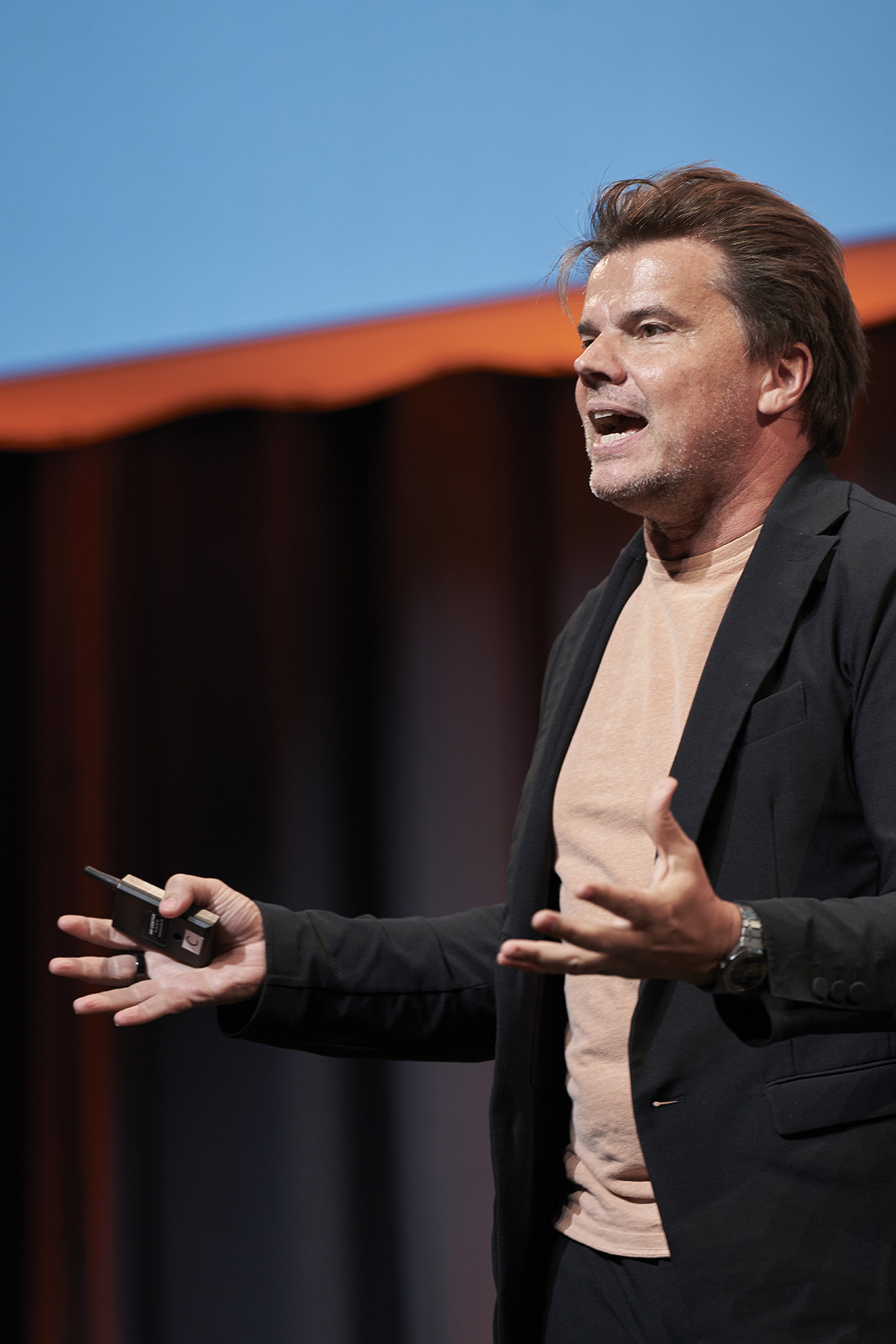
Bjarke Ingels is delivering a presentation on the stage at the Bella Center. Image courtesy of UIA World Congress of Architects 2023
Ingels also believes that there is no need to wait for "incredible inventions" to make an impact or take an action, possible solutions could be made with existing methods and available technology.
"Is it possible to sustain 10 billion people with the quality of life of Denmark? Yes, it is," the architect asked during his presentation.
"Do we need to wait for incredible inventions to be made before we start taking action? Or, can we actually use the technologies we already have available? And, the answer is that with existing methods, it is possible," he continued.

The Plus furniture factory was designed for Norwegian furniture manufacturer Vestre in the heart of a Norwegian forest. Image © Einar Aslaksen
Ingels talked about BIG's recent environmental-friendly projects, including The Plus furniture factory in the heart of a Norwegian forest, explaining that how the building was built from locally-sourced timber. "The building is powered with local hydro-electricity, geothermal energy and the sun," he added.
In addition, he explained how the new Zurich Airport "will be the biggest timber building on earth."
He said that "when you land in Zurich in 2032, the smell of pine will need you as you arrive, of course, significantly lowering the carbon footprint of the building."
The architect also talked about the key energy features of the Joint Research Centre (JRC Sevilla) in Spain, which was designed for the European Commission, and Google HQ, featuring a dragonscale solar skin.
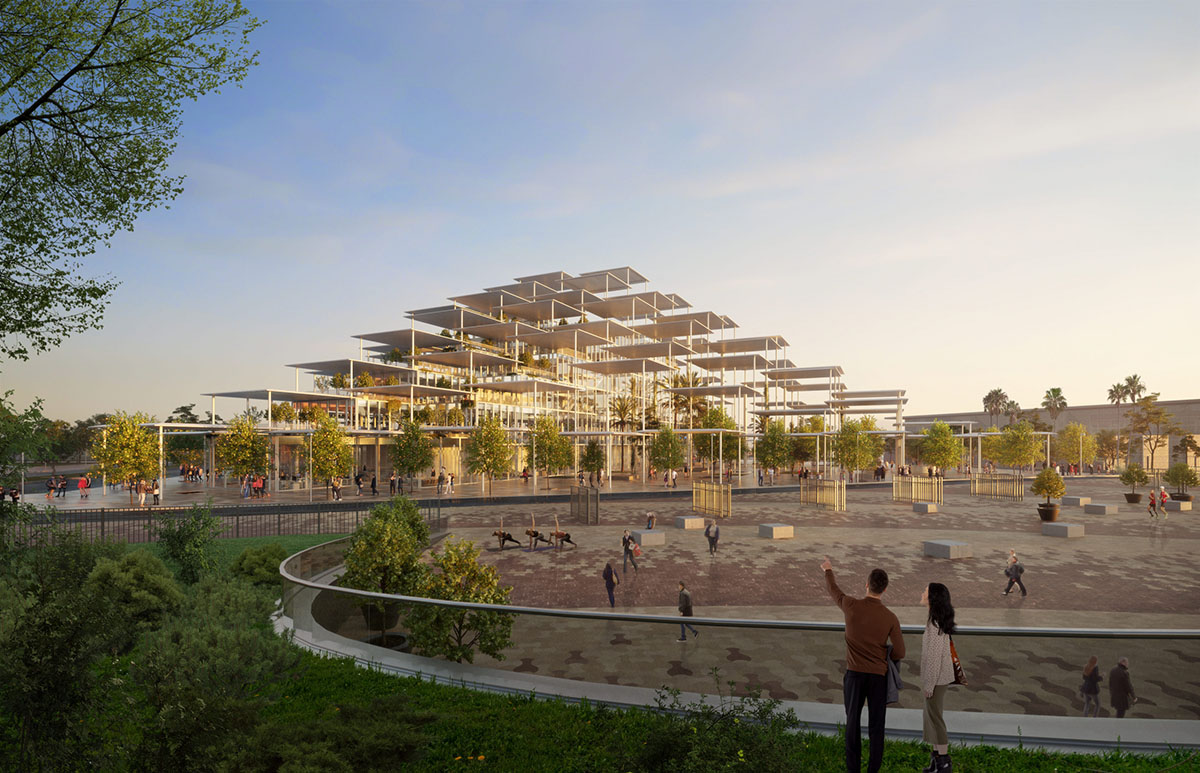
BIG's Joint Research Centre (JRC Sevilla) in Spain which aims to achieve the city of Sevilla’s goal to become a global benchmark for sustainability by 2025. Image © Playtime
According to Bjarke Ingels, the presence of these energy-focused, built projects can also provide an access to some valuable information by other parties. These projects can be used as "a sort of open source, or a crowd-source, online resource."
Ingels explained that "we've been thinking what to do with this research that we essentially did for our own sake. However, when we want to know something, we "Google" it quickly just to get some information."
"If you want dive deeper, maybe you can go to Wikipedia and find some more information. We find some more articles. But, what if we plan for the planet that could be a sort of open source, or a crowd-source, online resource?. People are normally spending a lot of energy on the work that they do."
"So we don't have excess energy too, to become researchers in climate change. If you could go these sources, like explain who you are and what you're doing in a very legible, tangible way, you can get access to all of the actions you can take with within your in the world," he added.
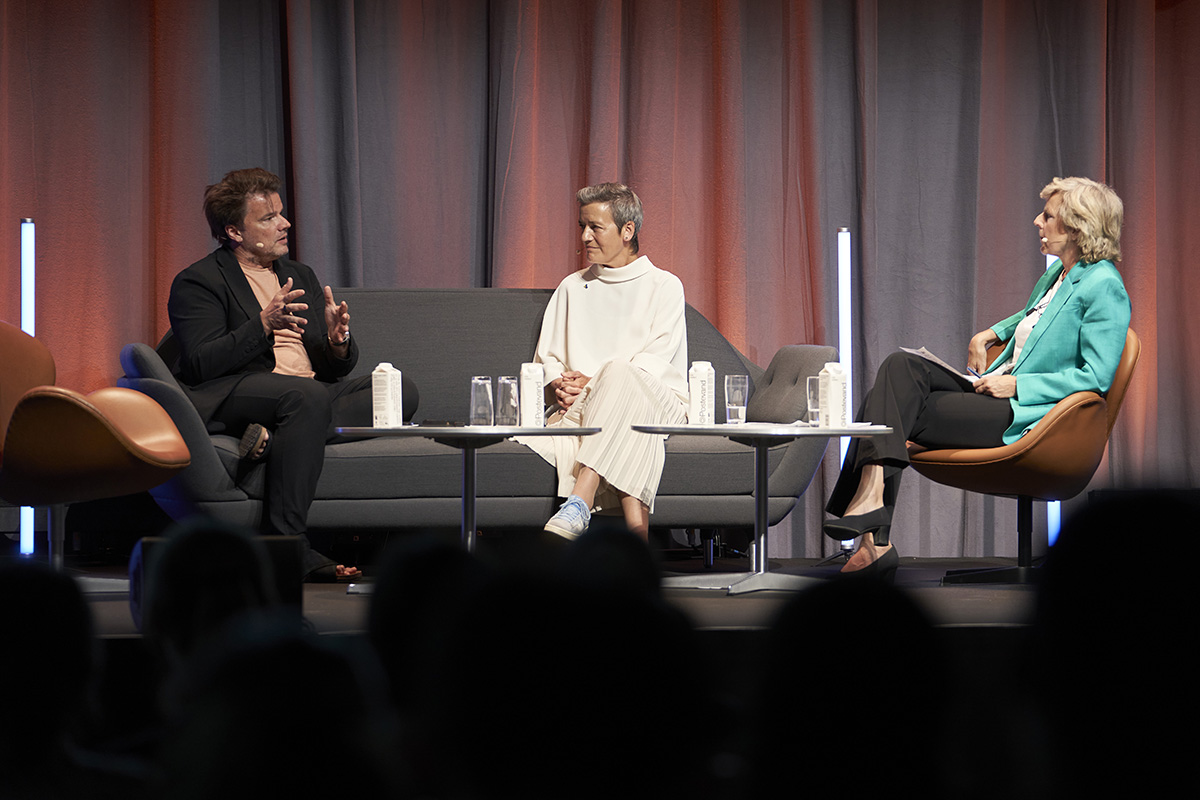
Keynote dialogue (from left to right): Bjarke Ingels, Margrethe Vestager and Connie Hedegaard. Image courtesy of UIA World Congress of Architects 2023
"The role of architects is to make more sustainable alternative in a more desirable way that makes it more choosable way"
At the end of the presentation, the panel talk with Bjarke Ingels, Margrethe Vestager and Connie Hedegaard focused on the role of an architect individually and collectively in a political agenda.
Ingels said that "architects have been very good at taking credit and blame for things that are essentially outside our power." "The political power is those who create the framework set for demands and also defines what is possible to do."
"Then you have the political power, which in a country like Denmark, those are the people that allocate the, the resources that you get invested into building and renovating neighborhoods in our cities."
"And the architects have the possibility to assist in that," said Ingels.
"But big decisions, are obviously made by someone else."
"The role of architects is to make more sustainable alternative in a more desirable way that makes it more choosable way. That's the role of architects as the specifiers, we can put enough energy in trying to put out some desirable alternatives that can be chosen," Ingels continued.
Keynote dialogue (from left to right): Bjarke Ingels, Margrethe Vestager and Connie Hedegaard. Image © Gul Kozacioglu
Compared to the past and today's political power and dynamics, "today we have a transition that is politically motivated and politically decided," according to Margrethe Vestager.
"There is a different responsibility on the states to do something more. I think one part of the responsibility is to make sure that this is a just transition, that it is indeed inclusive because the previous transitions have not been inclusive," she added.
"You need a combination of regulation, funding, incentives in order for the market to deliver, because the market will not deliver what we need in the necessary speeds." "That of course, it's the paradox. And I think there is a communication challenge here, it also obvious that you invest a bit more now to prevent further costs in the future."
"[Clients] actually have an incentive, they're not just selling a bunch of condos in the next year"
Evaluating the concept of sustainability in terms of client perspective, Bjarke Ingels believes that the evolution of the technology also changed the minset of clients and developers.
Ingels said that "clients are not the holders of the asset, they actually have an incentive, they're not just selling a bunch of condos in the next year."
"They actually will live with all the advantages and disadvantages of the choices they make now and in perpetuity. And I think there are two tools that have become available today that earlier generations didn't have," he added.
"I think there's a relatively sophisticated modeling, and for example, as part of the EU legislation, we are obliged to submit lifecycle analysis when we submit projects."
"This means that you don't just look at the now picture, you look at in 50 year, namely, certain decisions might not be so advantageous tomorrow, but in a fifty year perspective and that changes the mindset."
He added that "we still do some externalities, you have certain economic practices that have a lot of unaccounted externalities. And those externalities are actually currently negative, both ecologically but also economically. But we don't account for them, so they're just outside our spreadsheet."
"So it is becoming possible and even feasible to monitor and account for initiatives at a global scale in ways that were unimaginable 10 or 20 years ago."
Keynote dialogue (from left to right): Bjarke Ingels, Margrethe Vestager and Connie Hedegaard. Image © Gul Kozacioglu
Margrethe Vestager said that "obviously, the European Union is not perfect in what we do, but we have taken one lesson: it's always cheaper to tax the bad than to support the good."
"So this is why we have the emission freight system, where you put the tax on carbon and now this will be large also for transport and for buildings."
"I think that is a very tangible way of sort of taking externalities, putting a price tag on them so that all of a sudden it's a much more obvious choice to go with what is long term sustainable," she added.
"Sustainability has no premium in the long perspective"
Moreover, the talk briefly touched upon on the new and potential ways of developments in informal settlements. According to Ingels, "architects have to think almost in a strangely scalable market model".
"There is a need to thinking at an industrial scale to address the human scale," he said.
"There are a billion people living in informal settlements, 800 million living in slums, but, a billion living in informal settlements. But by 2050, that number would be 2.3 billion. That means that you will have like fast neighborhoods and even cities that are actually unplanned," the architect continued.
"So you have to think almost in a strangely scalable market model because like one of the things that have had the biggest impact on life in informal settlements is the availability of cheap corrugated sheet metal. This is an interesting market; there is a need to thinking at an industrial scale to address the human scale."
"But I think the best way to deal with it, you can increase the speed of the energy transition; and is to find legislative requirements or incentives that forces everybody making any choice today to take into account 50 years into the future - if it's a carbon tax, or carbon currency, whatever it is if it allows you to make rational and sort of economically sound choices today that take into account not just the shortsighted but the long sided."
"I would definitely make the argument that sustainability has no premium in the long perspective. It has a premium now."
At the end of the talk, circularity in the buildings was also discussed. According to the architect, the emotional connection and ownership of people with the building is also part of the notion of circularity.
"There's nothing more sustainable than building buildings that inspire the emotional connection of the people that inhabit them," said Ingels.
"I think that idea of actually designing great buildings that the people will go out of their way to maintain is probably the best you can do."
"But we have to apply a kind of creative holistic mindset in other industries like agriculture, energy sector, and infrastructure so that we don't leave all the hard problems just to the engineers to solve it," he concluded.
Top image in the article: Bjarke Ingels on stage, courtesy of UIA World Congress of Architects 2023.
> via UIA World Congress of Architects
BIG Bjarke Ingels sustainability UIA UIA World Congress of Architects
